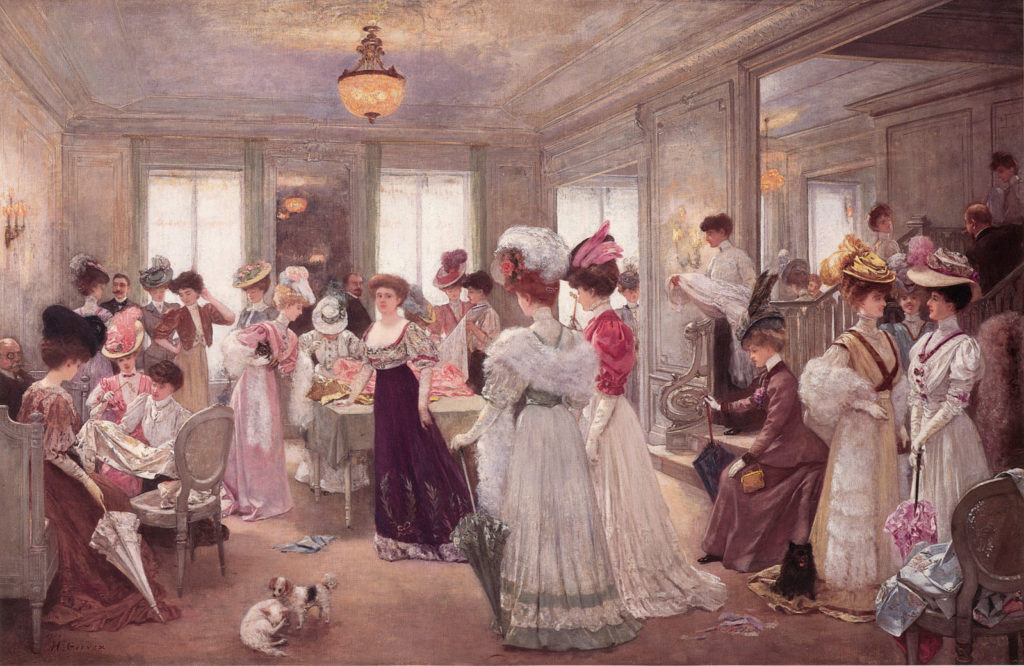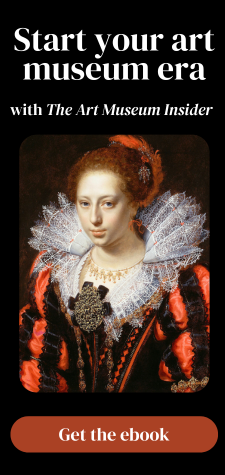Guest post by Julia Westerman, art and fashion historian
“Clothes express the epoch; that is Madame Paquin’s dictum.” —Charles Dawbarn, 1915

Introducing Jeanne Paquin
On the fourteenth of April in the year 1900, Paris opened its fifth Exposition Universelle, or World’s Fair. From 1855 onwards, Paris held World’s Fairs at regular eleven-year intervals, displaying new technologies and fine arts. The 1900 World’s Fair celebrated the achievements of the previous century and looked forward to the next one, welcoming 50 million visitors between April and November.
The entry gate to the World’s Fair was designed by French architect René Binet, and stood on the Place de la Concorde at the end of the Cours la Reine. The Porte Binet, as it was named, was a massive, skeletal structure comprised of a dome resting on three arches, underneath which were fifty-six ticket offices. The entire structure was embellished with crystals that reflected sunlight in the daytime and glowed with electric light during the night.
At the top of Binet’s dome stood a fifteen-foot tall plaster sculpture of a woman, called La Parisienne,created by sculptor Paul Moreau-Vauthier. The gown worn by La Parisienne was designed by the young female couturier Jeanne Paquin, who had opened the doors of her first Parisian boutique only five years earlier.
Paquin, whose name has been all but forgotten in comparison to her more famous male contemporaries, Charles Frederick Worth and Paul Poiret, was an instrumental figure in the formation of the fashion system in Belle Époque Paris. Her exceptional contributions to the world of couture were exemplified at the 1900 World’s Fair, where she not only designed the costume worn by Moreau-Vathier’s sculpture, but designed the entire fashion pavilion.
The Palais de la Mode, or fashion pavilion, summarized the history of fashion as a spectacle on a grand scale.It included wax displays of Empress Theodora, Marie Antoinette, and other historical figures. Modern fashion was represented by large scenes in glass cases, showing mannequins in opulent settings wearing the very latest styles by Worth, Paquin, Doucet, and others. Following the French Revolution, the figure of Marianne, the personification of French liberty, equality, fraternity and reason, had been the masthead of France. At the 1900 Exposition Universelle, La Parisienne, towering fifteen feet tall and dressed head to toe in Paquin, became the national personification of France: a female consumer of couture.
Who Was Jeanne Paquin?
Jeanne Paquin was born Jeanne Marie Charlotte Beckers in 1869 in Saint-Denis, France. Raised on the outskirts of Paris, the young Paquin trained as a dressmaker. As a young woman, she rose quickly through the ranks of the dressmaking shop in which she worked. In 1890, she married Isidore Rene Jacob, whose family owned a menswear shop. With her husband’s family’s shop and support, Paquin opened her own boutique in 1895, which quickly became successful.
As the nineteenth century came to a close, the Flâneur—the archetypal male figure of late nineteenth-century Paris who strolled the streets of the city in a black suit and top hat, observing the world—found his counterpart in the female shopper, who explored the floors of Le Bon Marché. The growth of the fashion industry allowed the young Jeanne Paquin to grow her business exponentially in the last five years of the nineteenth century. By the time of the 1900 Exposition Universelle, Paquin had expanded her business beyond her Paris boutique, with shops in London, Madrid, Buenos Aires, and New York. At the peak of her success, Paquin employed over 2,000 people around the world. In 1913, she became the first female couturier to be awarded the French Legion of Honour.
History Through Paquin’s Eyes
History is a consistent thread through Paquin’s work. She incorporated many neoclassical elements into her lavish designs, and often named them after prominent figures from the French Revolutionary period, such as “Thermidor,” and “Marie Antoinette.” For her 1899 Spring collection, Jeanne Paquin designed a dress she called “Vigée-Lebrun.” This dress clearly referred to the eighteenth-century painter Élisabeth Vigée-Lebrun. Like Vigée-Lebrun’s portraiture style, Paquin’s dress bridged the gap between Rococo and Neoclassicism. The gown is created in a classic turn-of-the-century silhouette, with cap sleeves, an accentuated waist, and a slim fitting a-line skirt with a train.

Right: Élisabeth Vigée-Lebrun, Self-Portrait with a Straw Hat, 1782. National Gallery, London
The dress is embellished in Rococo motifs such as small bows and flowers. The neckline and sleeves of the dress reflect the simple peasant styles of dress that Vigée-Lebrun favored for her sitters. Vigée-Lebrun’s name appears again in Paquin’s 1900 collection. The fact that Paquin named two of her dresses after the artist prompts a comparison between the two women. Vigée-Lebrun was immensely successful despite her gender, at a time when there were very few successful female portraitists. Her self-representation as a mother and as an extremely feminine woman may explain her success, just as Paquin’s own self-representation as a stylish but still overwhelmingly feminine woman allowed her to be so commercially successful.
One evening gown by Paquin evening gown housed in the collection of the Metropolitan Museum of Art is a Neoclassical gown with a high, empire waistline and an even higher back. It is reminiscent of the Directoire styles worn following the French Revolution, over one hundred years before Paquin created this gown. The top of the gown is typical of Paquin’s designs, featuring layers of thin silk tulle and short ruched sleeves. The bodice is decorated with three-dimensional floral motifs, twisting green vines and small fabric flowers. The bodice is finished with peach-colored ribbon, which also marks the waistline and sleeves. The peach-colored ribbon also features prominently in the hemline of the dress, which is decorated with a Greek key design.
Right: Jeanne Paquin, “Malesherbes” design for Winter 1905. Victoria and Albert Museum, E.1115-1957.
This design is characteristic of ancient Greek and Roman architecture, and features in many Neoclassical designs. Above the meandering pattern are many small laurel wreaths, another classic Neoclassical motif, which are embroidered into the layers of the gown. Crucially, this Paquin dress from 1905 incorporated Neoclassical elements years before Paul Poiret began experimenting with similar motifs. The sketch for this dress is in the Victoria & Albert Museum archives, in Paquin’s collection for Winter 1905.
Comparing Paquin’s sketch with the actual gown provides valuable insight into Paquin’s working methods. It also helps us to visualize the gowns that her house produced, based on other sketches that still exist in the archives. Although the dress had short sleeves, it was clearly intended to be worn with full-length evening gloves that met the sleeve above the bicep of the wearer. The dress is called “Malesherbes,” which may refer to a geographic location in France. But given Paquin’s tradition of naming dresses after historical figures, it most likely refers to Guillaume-Chrétien de Lamoignon de Malesherbes, a French statesman in the ancien régime who was guillotined in 1794.
Paquin: Singular in Gender and Style
Despite her abundant contributions to Belle Époque fashion, Paquin is not well remembered today. While there have been retrospective exhibitions of her male contemporaries Paul Poiret and Charles Frederick Worth, Paquin has been a long-neglected figure in the history of French couture. Her designs were overwhelmingly feminine, in contrast to Poiret’s more Orientalist style that introduced harem style trousers and hobble skirts.
Jeanne Paquin is an example of a female couturier who designed with other women like herself in mind. She championed a more traditional French style at a time when Europe was becoming more nationalistic in years preceding the First World War. Paquin’s incorporation of French history, and her refusal to embrace the Orientalist styles of Poiret and others, show her as a steadfast and shrewd businesswoman. As a couturier, she knew her clients intimately, and created for them glorious confections of womanhood that were unabashedly feminine.
Julia Westerman is a New York born and raised art and fashion historian, living and working in London. She received her BA in Art History from the University of St Andrews, and her MA from University College London. This article is an abridged version of her MA dissertation, written in 2019, which examined in detail the Jeanne Paquin archives at the Victoria and Albert Museum. She specializes in eighteenth- and nineteenth-century women’s fashion and portraiture. You can find her on social media at @JuliaWesterman9 (Twitter) and @Julia.Westerman (Instagram).
Other Art Herstory blog posts you might enjoy:
Blanche Hoschedé-Monet: An Artist in Her Own Right, by Rebekah Hoke Brown
Unpacking the Exhibition: Blanche Hoschedé-Monet in the Light, by Haley S. Pierce
Marie Laurencin: Sapphic Paris, A Review, by Alice M. Rudy Price
The Rich and Complex Character of May Morris, Designer, Embroiderer, Jeweller and Writer, by Thomas Cooper
Marie Spartali Stillman’s The Last Sight of Fiammetta, by Margaretta S. Frederick
Visual Feasts: The Art of Sarah Mapps Douglass, by Erika Piola
Portraying May Alcott Nieriker, by Julia Dabbs
Anna Ancher’s Vaccination and Scientific Motherhood, by Alice Price
Marie Laurencin and the Autonomy of Self-Representation, by Mary Creed
The Many Faces of Suzanne Valadon, by Dr. Suzanne Singletary
Madeleine Françoise Basseporte’s Hyacinths at the French Court, by Mary Creed
Anna Boberg: Artist, Wife, Polar Explorer, by Dr. Isabelle Gapp
The Ongoing Revival of Matilda Browne, American Impressionist, by Alexandra Kiely
Esther Pressoir: Imagining the Modern Woman, by Dr. Suzanne Scanlan
Adélaïde Labille-Guiard: Artist, Friend, Teacher, by Dr. Jessica L. Fripp
From a Project on Women Artists: The Calendar and the Cat Lady, by Dr. Lisa Kirch
Seductive Surfaces: Anne Vallayer-Coster’s Vase of Flowers and Conch Shell at the Met, by Dr. Kelsey Brosnan
Marie-Guillemine Benoist, Revolutionary Painter, by Paris Spies-Gans
The Life and Art of Dorothea Tanning, by Dr. Victoria Carruthers
“Black-works, white-works, colours all”: Finding Susanna Perwich in her Seventeenth-Century Embroidered Cabinet, by Isabella Rosner
Warp and Weft: Women as Custodians of Jewish Heritage in Italy, by Dr. Anastazja Buttitta
Victorine Meurent, More than a Model, by novelist Drēma Drudge
The Abstract-Impressionism of Berthe Morisot and Joan Mitchell, by novelist Paula Butterfield



